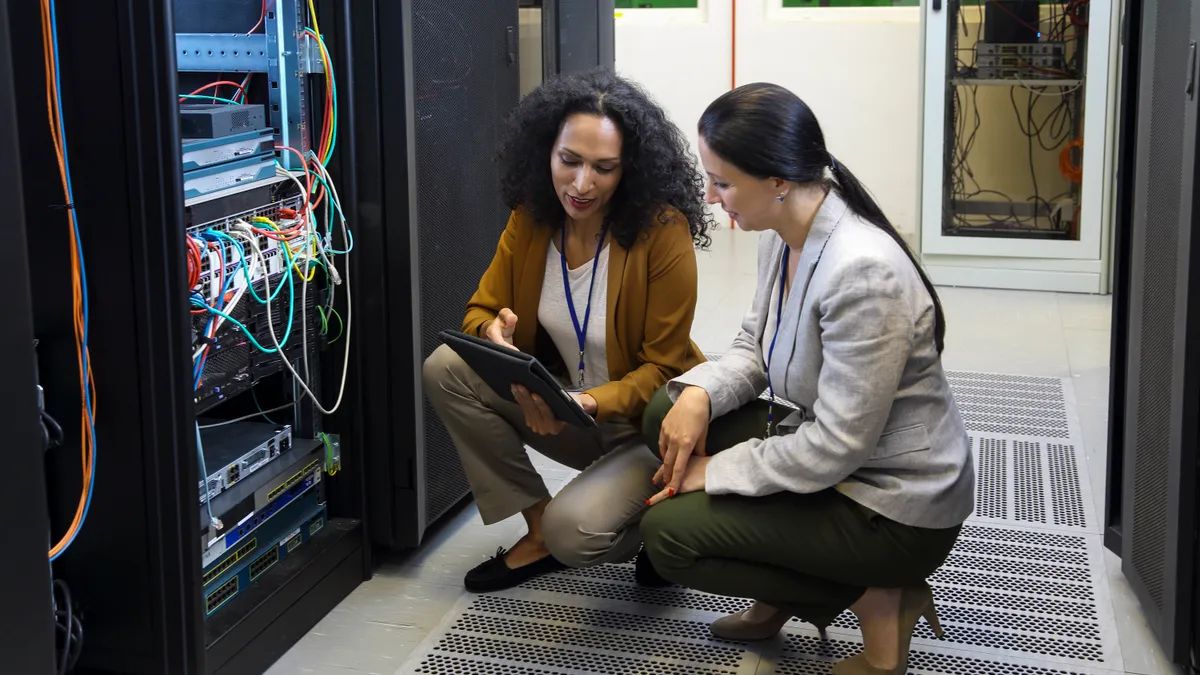Giving women a seat at the (kitchen) table was an explicit factor in Kelley Berlin’s decision to launch a returnship program.
In 2021 and 2022, Grubhub has welcomed caregivers — mostly women — to its software engineer team via its Reconnect Returnship, a four-month program. “We know it can be difficult for those who have taken time away from their career to rejoin the workforce,” Berlin, Grubhub’s CHRO, acknowledged via email. It’s why she and her team made a point to center talent with caregiving responsibilities.
Berlin told HR Dive that it started with her team critically assessing company initiatives, partnerships and processes for areas of improvement. The audit led them to representation gaps; they then partnered with O’Reilly Media, a learning and development company, to connect potential returnees with education material.
For HR leads looking to implement diverse hiring, the returnship model may make an excellent case study. HR Dive has covered the launch and subsequent success of PepsiCo’s returnship program, which was also centered on caregivers. Along with Goldman Sachs and JPMorgan Chase, leadership at Schneider Electric also sought to bring underrepresented caregiving talent back to their field.
Anecdotally, since the launch of Grubhub’s returnship program, leadership told HR Dive that the food delivery company has seen an increase in diversity. (For context: 80% of the first Reconnect cohort converted to full-time employees at the returnship’s end.) But not only did the caregiver returnship improve gender diversity; it brought diversity of age and experience to the table as well, said Laura Baldwin.
Baldwin, president of Grubhub’s technical partner O’Reilly Media, acknowledged the mass exodus of people — largely women — from the workforce at the pandemic’s onset, due to child care-related concerns. “Yet these career breaks are often stigmatized and caregivers can find it difficult to reenter the job market,” Baldwin noted.
This phenomenon catalyzed teams at Grubhub and O’Reilly to create a learning and development program to reengage women in the workforce. It’s worth noting that the program is 100% virtual for accessibility.
Originally, the program centered around software engineers, but 2023’s Reconnect programming is geared toward marketing and finance professionals looking to return to the workforce. The program’s change occurred, Berlin explained, due to Grubhub’s business needs heading into 2023. “The training content and modules will look different compared to the engineering-focused ones, but that’s the only shift,” she said.
As one can imagine, the recruiting process for returnship candidates is tailored to the situation; Berlin asks questions about past experience versus current experience, mindful of the resume gap. Grubhub managers also go through training to help “set up the returnees to be successful,” she said. “Throughout the process, we’re looking for individuals who demonstrate a willingness to learn, coachability and overall curiosity.”
Both of the leads had advice for HR Dive readers considering returnships as a solution to representation issues or talent shortages. Baldwin’s counsel: Look behind the daily dump of layoff news and recognize the potential in tech’s shifting landscape.
“Organizations are struggling to fill open positions. And the market for STEM roles is only growing, with the number of jobs estimated to rise 15% by 2031,” she said. This projection presents a “tremendous” opportunity for talent looking to get back to the workplace, she explained. Upskilling this talent and getting them acquainted with new technologies “can help prove their viability as candidates.”
Ultimately, centering L&D is Baldwin’s solution. Not only is it a recruiting tactic, but it can be valuable for retention, too; “Invest in your people’s professional development if you want them to stick around.”
Berlin’s advice was focused on transparency. “Communication has always been key, and for returnees, we know there can be a lot of stress about the unknown of the program since it is a contract-to-hire role. A returnee could be performing well but still have nerves about their conversion to a full-time employee given the nature of the program,” Berlin said. “We do our best to mitigate any ambiguity through clear and constant communication so that returnees feel good knowing exactly where they stand and what they can expect moving forward.”























